Right upper wishbone removed (02 – 03 March 2003)
Things have been getting too clean with the floors fitting and being sealed with POR-15. This weekend I turned to the front frame that we had removed long ago with 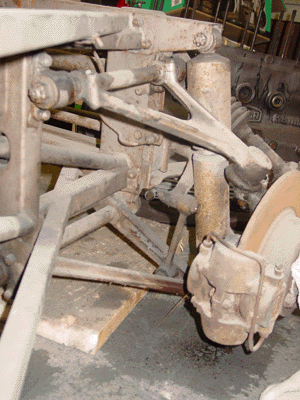 the front suspension and steering mechanisms intact. The entire structure needs to be completely taken apart so that the steering, the suspension assemblies and the three-part frame itself can be thoroughly cleaned and, as the case may be, renewed.
the front suspension and steering mechanisms intact. The entire structure needs to be completely taken apart so that the steering, the suspension assemblies and the three-part frame itself can be thoroughly cleaned and, as the case may be, renewed.
I focused on the right suspension system. Actually much of the work consisted of spraying penetrating fluid on the nuts and bolts that needed to be removed or loosened. These nuts and bolts have been painted the body color, and as a matter of fact the shock absorber (the original Girling) and the upper wishbone itself were the body color of the car. That’s a very good indication that the car had been painted, since the original shocks were “Girling blue” and the upper wishbone was plated. I’m going to carefully remove the paint on both of these items to see what lies beneath the paint. To tell the truth, I have no idea what “Girling blue” really looks like. On all the photographs I’ve studied, I’ve never seen it. Depending on the shape of these shock absorbers, I might keep them and reinstall them. When I took ownership of the car, I did bounce it around a bit. The rear shocks were shot, but the front shocks seemed good still.
By the way, the English call shock absorbers “dampeners.” I was a little confused by the term when I was going through the shop manuals for guidance, and “dampeners” cause me to scratch my head a bit. But, of course, the name itself tells what the part does: dampen motion and “shock.”
I followed the shop manual instructions for removing the upper wishbone, since I have never done this kind of removal before. The instructions were quite good, but there was one problem with access to a bracket that holds the “fulcrum” of the wishbone onto the frame itself. The front bracket lies behind the shock absorber, and I found that 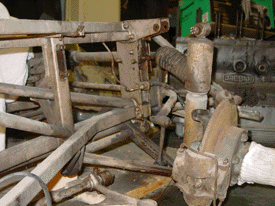 I had to remove the upper shock absorber fastener in order to gain access to it. This fitting had three very stubborn bolts that took a great deal of penetrating fluid and many taps on the wrench to remove. I was careful not to be too free with my hammer, since replacing these pieces could be a real challenge. All the hardware is grade 8, however. And so, it is quite tough. The bolts themselves look untouched by the forty-some years they’ve sat. I’m guessing the a coating of paint may just have given them some extra life.
I had to remove the upper shock absorber fastener in order to gain access to it. This fitting had three very stubborn bolts that took a great deal of penetrating fluid and many taps on the wrench to remove. I was careful not to be too free with my hammer, since replacing these pieces could be a real challenge. All the hardware is grade 8, however. And so, it is quite tough. The bolts themselves look untouched by the forty-some years they’ve sat. I’m guessing the a coating of paint may just have given them some extra life.
It would have been nice to remove the entire suspension assembly on the right, but some of the nuts and bolts are very much stuck. I figure I would treat them with penetrating fluid over the week and see if they will loosen up.
Smallish stuff
I am anxious to flip the car back to its normal state, since seeing the floors now has become tedious. I did some preparatory work to sealing the floors with POR-15, and this has required a bit of an adjustment in timeframe. I was hoping to get the entire floor coated with POR-15 this weekend, but the problem was fitting the rear floor stiffener. This piece covers an area of the floor that I definitely want to coat with POR-15, but that section becomes inaccessible once the stiffener is in place. As a result, I have to POR-15 the section before placing the stiffener. This takes planning — and time. Everything is now set, and I am planning on having the entire 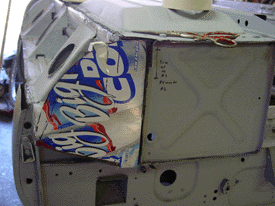 floor sealed by the end of the week.
floor sealed by the end of the week.
The front end of the inner sill (the piece that is part of the front bulkhead) still needs to be fabricated. Today I found the template I used for the corresponding piece on the other side of the vehicle. With a simple flip, the template works for this side as well. I fitted the cardboard piece to the area to see what adjustments might need to be made. None needed. I can cut this piece and fit it sometime this week in the evening.
I’ve thought about calling one of these little chapters “The Car That Was Made Of Cardboard” — appropriate, since without cardboard from pop containers, the metalwork would have been much harder!
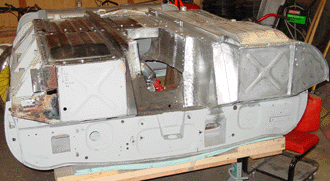 welding, and Aaron did the welding, for the most part. As I said in the
welding, and Aaron did the welding, for the most part. As I said in the 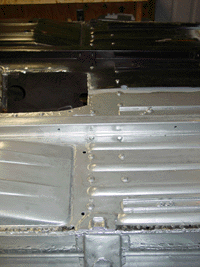 of the panel (along the seam of floor panel and outer sill) had a very natural fit. We basically just laid the panel on the car and welded. However, the central portion of the panel (behind the cross member where the right and left floor panels meet) seemed to bulge a bit. We will bolt that area in any case, and probably weld it as well. As I recall, the original floor panels had a separate panel attached in this area, which is the part that forms the “floor” of the drive shaft tunnel. I don’t know that this original panel was an original part, in any case. (I haven’t look at the notes or at the parts themselves, but this piece may actually have been something other than metal.) The pictures I have seen of this area don’t show a metal cover over the area. And yet, a sheet covering the area where the floor panels meet actually doesn’t sound like a bad idea.
of the panel (along the seam of floor panel and outer sill) had a very natural fit. We basically just laid the panel on the car and welded. However, the central portion of the panel (behind the cross member where the right and left floor panels meet) seemed to bulge a bit. We will bolt that area in any case, and probably weld it as well. As I recall, the original floor panels had a separate panel attached in this area, which is the part that forms the “floor” of the drive shaft tunnel. I don’t know that this original panel was an original part, in any case. (I haven’t look at the notes or at the parts themselves, but this piece may actually have been something other than metal.) The pictures I have seen of this area don’t show a metal cover over the area. And yet, a sheet covering the area where the floor panels meet actually doesn’t sound like a bad idea.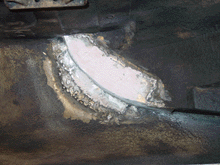 interior meets the lower edge of the convertible top. This area has been badly corroded, and crudely “fixed” with Bondo and wood strips (!). We had removed this blodged repair, and intended on doing some metal work. That we did, with two pieces of 20-gauge metal. The first piece was aligned with the curve of the upper portion of the left rear quarter panel, and the second piece (welded on top of the first piece from inside the wheel well) formed the fillet wall. As with other fixes, we ground off the welding excesses, and used Bondo to smooth the surface. We were actually less worried about how this fix looked, since it is in a place where you really need to want to look to see it at all. After the application of Rock Guard to the area, this fix won’t be easily visible. But trained eyes will see it, I guess. If they look for it….
interior meets the lower edge of the convertible top. This area has been badly corroded, and crudely “fixed” with Bondo and wood strips (!). We had removed this blodged repair, and intended on doing some metal work. That we did, with two pieces of 20-gauge metal. The first piece was aligned with the curve of the upper portion of the left rear quarter panel, and the second piece (welded on top of the first piece from inside the wheel well) formed the fillet wall. As with other fixes, we ground off the welding excesses, and used Bondo to smooth the surface. We were actually less worried about how this fix looked, since it is in a place where you really need to want to look to see it at all. After the application of Rock Guard to the area, this fix won’t be easily visible. But trained eyes will see it, I guess. If they look for it….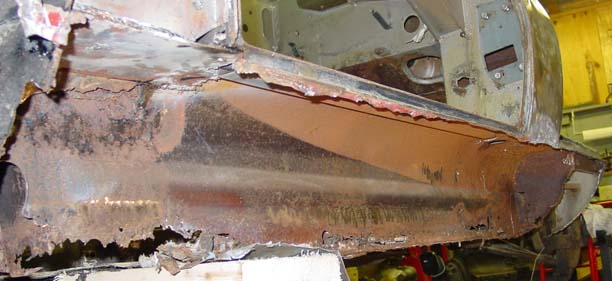
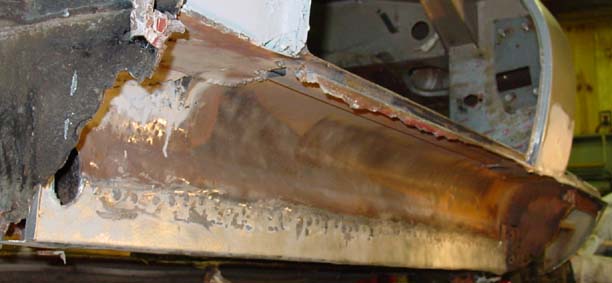
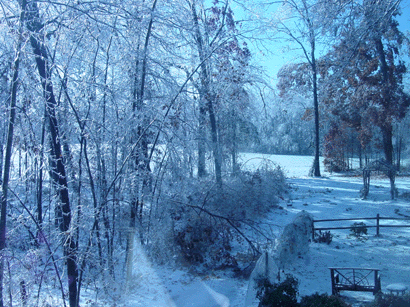 It did.
It did.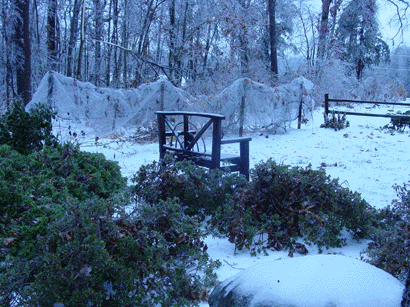 the uninterruptible power sources complained for a while before failing entirely. I got up to let the dog out, and took a look toward Durham to the south. The sky was lit with what appeared like lightning, though it was probably transformers making fireworks.
the uninterruptible power sources complained for a while before failing entirely. I got up to let the dog out, and took a look toward Durham to the south. The sky was lit with what appeared like lightning, though it was probably transformers making fireworks.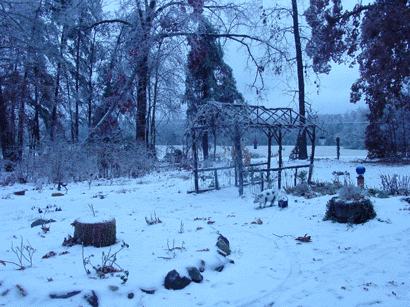
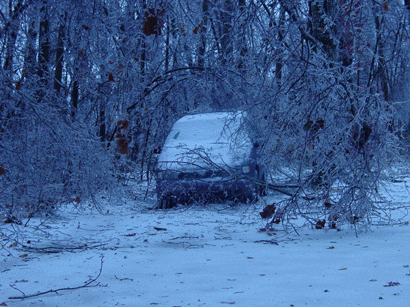
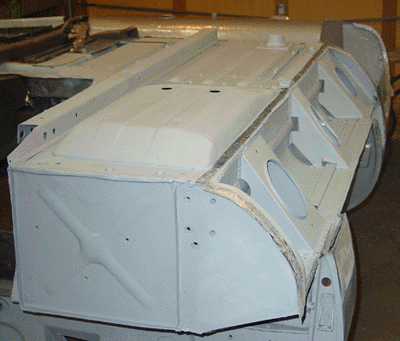 I do wish we were done with metalwork on the “tub” — the car body. We haven’t touched the bonnet, we’ve done very little with the doors and the trunk lid, and the engine and other mechanicals are practically untouched.
I do wish we were done with metalwork on the “tub” — the car body. We haven’t touched the bonnet, we’ve done very little with the doors and the trunk lid, and the engine and other mechanicals are practically untouched.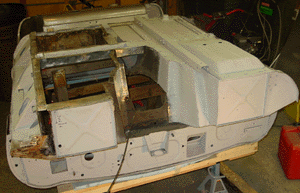 any) given to the body was no longer needed, so we cut it free and removed the vestiges of the left floor. This freed up the otherwise inaccessible space behind the interior rear bulkhead and the part of the bulkhead that faces the independent rear suspension (IRS) — a void of about 3-4 centimeters wide running laterally across the car. I vacuumed the dust and dirt that had accumulated, brushed off what I could, and Rustoleum primed the entire inside of the void. I really wonder why the car was designed to have this inaccessible area, since once the floor panels are on, you can’t rustproof or paint anything in the void.
any) given to the body was no longer needed, so we cut it free and removed the vestiges of the left floor. This freed up the otherwise inaccessible space behind the interior rear bulkhead and the part of the bulkhead that faces the independent rear suspension (IRS) — a void of about 3-4 centimeters wide running laterally across the car. I vacuumed the dust and dirt that had accumulated, brushed off what I could, and Rustoleum primed the entire inside of the void. I really wonder why the car was designed to have this inaccessible area, since once the floor panels are on, you can’t rustproof or paint anything in the void.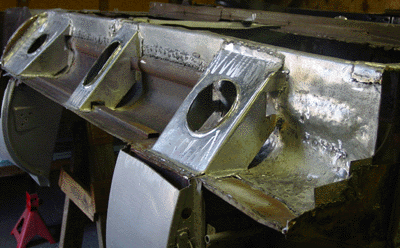 and used it to fashion the piece. The stiffeners were made from 20-gauge steel, and I fashioned the middle stiffener from the design I used for the middle stiffener done for the right sill. The secret is to be generous in your measurements for the tabs that you use to weld to the sill. It is easy to cut metal away, but not so easy to add it.
and used it to fashion the piece. The stiffeners were made from 20-gauge steel, and I fashioned the middle stiffener from the design I used for the middle stiffener done for the right sill. The secret is to be generous in your measurements for the tabs that you use to weld to the sill. It is easy to cut metal away, but not so easy to add it.
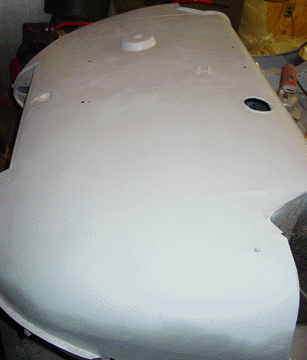 place, too. I reprimed the mounting cap and the area on the floor panel where it attaches. I used stainless steel hardware to attach the piece. Once it was fitted, I saw to it that the floor panel fit onto the frame well. I’ve decided to spot weld the panels after securing them with nuts and bolts. That way I can be assured that the panel is tightly affixed and the spot welds are firm. Bolts will go on the front of the panel, along the bell housing and transmission tunnel, and across the cross beam. The seam where the side outer sill attaches will not have any bolts, since it is easily visible from the side of the car, and the outer sill itself overlaps the floor panel. I don’t want to have to cut out clearances for bolts along the edge of the outer sill, and I don’t care to drill holes through the outer sill. Both of those seem to invite moisture and eventual rust.
place, too. I reprimed the mounting cap and the area on the floor panel where it attaches. I used stainless steel hardware to attach the piece. Once it was fitted, I saw to it that the floor panel fit onto the frame well. I’ve decided to spot weld the panels after securing them with nuts and bolts. That way I can be assured that the panel is tightly affixed and the spot welds are firm. Bolts will go on the front of the panel, along the bell housing and transmission tunnel, and across the cross beam. The seam where the side outer sill attaches will not have any bolts, since it is easily visible from the side of the car, and the outer sill itself overlaps the floor panel. I don’t want to have to cut out clearances for bolts along the edge of the outer sill, and I don’t care to drill holes through the outer sill. Both of those seem to invite moisture and eventual rust.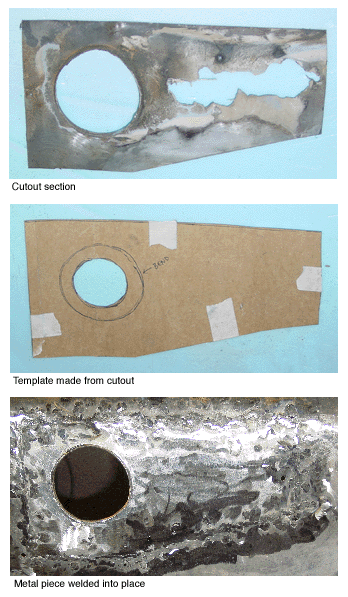 This fix was quite simple because the piece itself was flat, for the most part. The only complication was the hole for the fuel tank cannister that holds the fuel filter. I believe this part of the tank might be called the “sump.” The hole was flared, so there was some bending and stretching of the metal. I marked off the area to be cut out of the trunk floor and cut it with an angle grinder fitted with a steel cutting blade. The cut out piece quite literally served as the template for the template that I made out of cardboard from a case of soda cans. Really any flexible cardboard would do. Soda can cases are good because they have generous sides and are large enough for fairly good sized templates. (They are also plentiful in our household!)
This fix was quite simple because the piece itself was flat, for the most part. The only complication was the hole for the fuel tank cannister that holds the fuel filter. I believe this part of the tank might be called the “sump.” The hole was flared, so there was some bending and stretching of the metal. I marked off the area to be cut out of the trunk floor and cut it with an angle grinder fitted with a steel cutting blade. The cut out piece quite literally served as the template for the template that I made out of cardboard from a case of soda cans. Really any flexible cardboard would do. Soda can cases are good because they have generous sides and are large enough for fairly good sized templates. (They are also plentiful in our household!)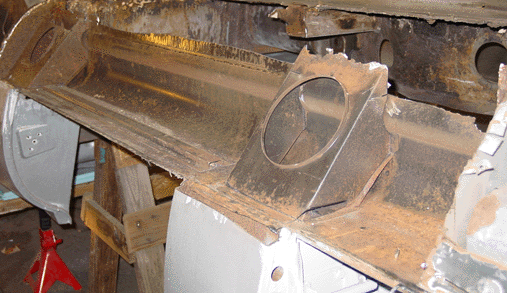 weekend, when we cut the hole clean and ground off the tabs left from the old rusted out outer sill. The corrosion on this sill was mainly in the front, with some rust buildup at the rear of the sill, under the rear stiffener. As with the right sill, there was corrosion nearest the floor as well (in the picture that would the the top edge of the sill, since the car is upside down). I went ahead and took off the rusted section all along the sill, so that we can repair the sill as one piece rather than in smaller sections. It seemed to me that an integrated repair would be more durable. This repair will be very similar to the
weekend, when we cut the hole clean and ground off the tabs left from the old rusted out outer sill. The corrosion on this sill was mainly in the front, with some rust buildup at the rear of the sill, under the rear stiffener. As with the right sill, there was corrosion nearest the floor as well (in the picture that would the the top edge of the sill, since the car is upside down). I went ahead and took off the rusted section all along the sill, so that we can repair the sill as one piece rather than in smaller sections. It seemed to me that an integrated repair would be more durable. This repair will be very similar to the 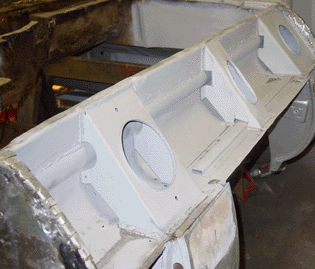 You might recall that
You might recall that 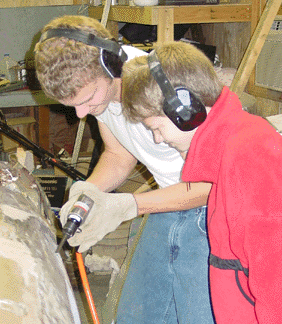 body panel, but the bottom portion did not. At the bottom edge, the metal was sticking out about 2 centimeters — a significant bulge to finesse with Bondo. I actually thought about just leaving well enough alone and using Bondo to cover the lower portion, and yet that seemed a bit sloppy. I ended up cutting off the portion of the metal that wasn’t tight and fashioning a plate to refit into the hole. I ground off the messy weld-metal, and refit the portion. It fit nicely. I then welded the two pieces together along the seam, and then ground o
body panel, but the bottom portion did not. At the bottom edge, the metal was sticking out about 2 centimeters — a significant bulge to finesse with Bondo. I actually thought about just leaving well enough alone and using Bondo to cover the lower portion, and yet that seemed a bit sloppy. I ended up cutting off the portion of the metal that wasn’t tight and fashioning a plate to refit into the hole. I ground off the messy weld-metal, and refit the portion. It fit nicely. I then welded the two pieces together along the seam, and then ground o ff the excess weld. Bondo flattened it up well enough. Since the hole was inset the thickness of the sheet metal inside the trunk area, I sanded and cleaned up the area around the hole and bondoed the indent so that it is flat. Of course, the fix lacks two of the creases that are normally found on this body panel, but this fix was good enough. It is strong, and since it is covered by upholstery, it will also be invisible.
ff the excess weld. Bondo flattened it up well enough. Since the hole was inset the thickness of the sheet metal inside the trunk area, I sanded and cleaned up the area around the hole and bondoed the indent so that it is flat. Of course, the fix lacks two of the creases that are normally found on this body panel, but this fix was good enough. It is strong, and since it is covered by upholstery, it will also be invisible.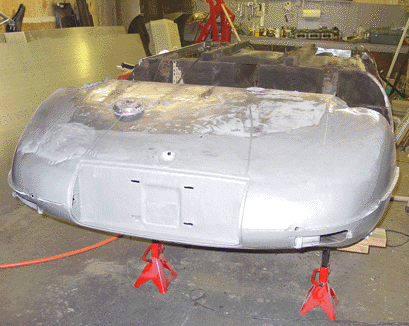 windshield. These could not bear the weight of the body, and we made sure that theynever touched the floor as we lifted and turned the body over. This was mainly a matter of placing the rear (the so-called “boot”) of the body on a pad on the floor, then removing the support from the front. Once the entire body rested on the floor we literally rolled the body onto its side. Then after having placed the support for the front where it could accept the body and support it, we lifted the front part of the body up, leaning a portion of the body weight onto the rear section. We settled the front onto the frame support, lifted the rear section and put the supports for the rear into place.
windshield. These could not bear the weight of the body, and we made sure that theynever touched the floor as we lifted and turned the body over. This was mainly a matter of placing the rear (the so-called “boot”) of the body on a pad on the floor, then removing the support from the front. Once the entire body rested on the floor we literally rolled the body onto its side. Then after having placed the support for the front where it could accept the body and support it, we lifted the front part of the body up, leaning a portion of the body weight onto the rear section. We settled the front onto the frame support, lifted the rear section and put the supports for the rear into place.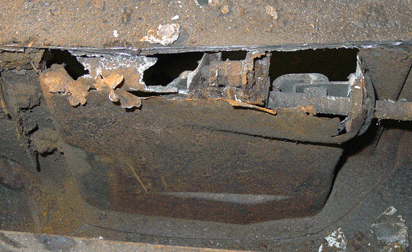 I was wrong, it turned out, since the bottom of the tranny tunnel hadn’t been well enough protected from moisture. The tunnel has a bit of an indentation on the driver’s side, where the emergency brake lever is situated. This piece contains the hinge for the lever, an electrical switch sensor that lights up the emergency brake light, and the cable housing leading to the rear brakes that are engaged by the emergency brake. (Incidently, the E-Type has a separate set of brake pads that are engaged by the emergency brake.) The bottom of the housing for the brake mechanicals and switch was completely absent — eaten away by moisture seeping and spraying from the road, presumably.
I was wrong, it turned out, since the bottom of the tranny tunnel hadn’t been well enough protected from moisture. The tunnel has a bit of an indentation on the driver’s side, where the emergency brake lever is situated. This piece contains the hinge for the lever, an electrical switch sensor that lights up the emergency brake light, and the cable housing leading to the rear brakes that are engaged by the emergency brake. (Incidently, the E-Type has a separate set of brake pads that are engaged by the emergency brake.) The bottom of the housing for the brake mechanicals and switch was completely absent — eaten away by moisture seeping and spraying from the road, presumably.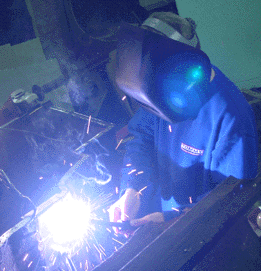 transmission bell housing. It’s not particularly clear what exactly required such invasive and destructive work to be done. I was thinking that perhaps there was simple laziness at the root of it. For typical adjustments, the E-type has adequate portholes going into the transmission area. But perhaps this was starter work? A clutch job (unlikely, I think)? We shall probably never know.
transmission bell housing. It’s not particularly clear what exactly required such invasive and destructive work to be done. I was thinking that perhaps there was simple laziness at the root of it. For typical adjustments, the E-type has adequate portholes going into the transmission area. But perhaps this was starter work? A clutch job (unlikely, I think)? We shall probably never know.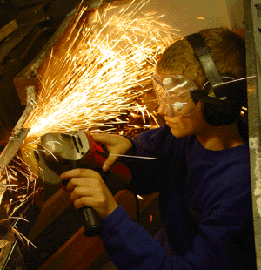 Anyway, I fashioned a replacement piece for the front engine/transmission housing wall out of 18-gauge steel, and I cut out the damaged piece from the transmission cowel. That piece we replaced with another piece of 18-gauge steel. Aaron did the welding and the grinding.
Anyway, I fashioned a replacement piece for the front engine/transmission housing wall out of 18-gauge steel, and I cut out the damaged piece from the transmission cowel. That piece we replaced with another piece of 18-gauge steel. Aaron did the welding and the grinding.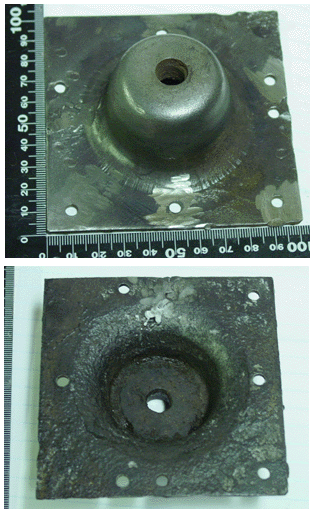 the existing cups and one of them was corroded beyond repair. I ordered a replacement for it. The other one still lingers in my mind as a repairable piece or as a replacement piece. We did go ahead and repair the cup that still has structural integrity, though questions remain because of the threading in the center of the coupling. They are not exactly well defined. I could, perhaps, go ahead and retap the threads with some success. At this point, we are going to wait until the new part arrives (sometimes after the Thanksgiving Holiday, I was told) and then we’ll make a decision about the replacement. I definitely do not want to install a restored part that will fail after a few thousand miles!
the existing cups and one of them was corroded beyond repair. I ordered a replacement for it. The other one still lingers in my mind as a repairable piece or as a replacement piece. We did go ahead and repair the cup that still has structural integrity, though questions remain because of the threading in the center of the coupling. They are not exactly well defined. I could, perhaps, go ahead and retap the threads with some success. At this point, we are going to wait until the new part arrives (sometimes after the Thanksgiving Holiday, I was told) and then we’ll make a decision about the replacement. I definitely do not want to install a restored part that will fail after a few thousand miles!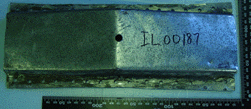
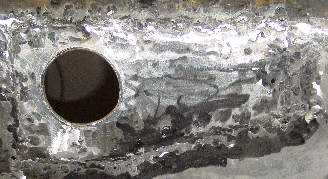 the paint from the inside of the trunk. The fix entailed cutting out the corrosion and the entire fuel filter cup hole, even though the rust damage was isolated to one side of the hole. I figured it would be easier to create an entire hole than it would be to try to fashion a piece and attach it flawlessly to the “good” metal of the original hole. Once again, this was a matter of exactly fashioning a replacement piece, welding tabs to the hole, and welding the new piece onto the tabs.
the paint from the inside of the trunk. The fix entailed cutting out the corrosion and the entire fuel filter cup hole, even though the rust damage was isolated to one side of the hole. I figured it would be easier to create an entire hole than it would be to try to fashion a piece and attach it flawlessly to the “good” metal of the original hole. Once again, this was a matter of exactly fashioning a replacement piece, welding tabs to the hole, and welding the new piece onto the tabs.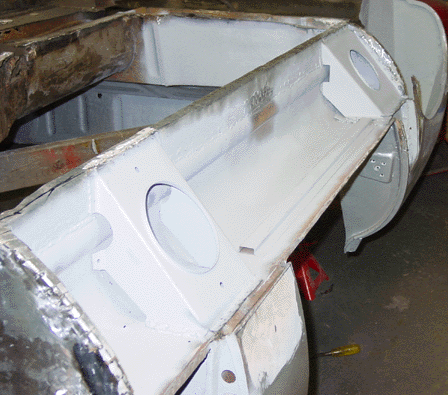 more than brackets that fit below the door frames — below the “B”-pillar in the rear and below the structure that holds the door hinges. They turn the (roughly) square sill into two triangles, and that’s why they are so good at stiffening the sills. I was thinking about putting a third sill stiffener in between the front and rear stiffeners, but after I got them in, it seemed as though there really wasn’t that much room between the stiffeners. At least not much to worry about. (I have seen a third stiffener installed by some restorers. They use a modified front stiffener.)
more than brackets that fit below the door frames — below the “B”-pillar in the rear and below the structure that holds the door hinges. They turn the (roughly) square sill into two triangles, and that’s why they are so good at stiffening the sills. I was thinking about putting a third sill stiffener in between the front and rear stiffeners, but after I got them in, it seemed as though there really wasn’t that much room between the stiffeners. At least not much to worry about. (I have seen a third stiffener installed by some restorers. They use a modified front stiffener.) After I installed the floors I was hoping to be able to install the “radius arm mount cups” — little fittings that hold the arms that come front from the independent rear suspension. But, the mounting cups need to be put into place before the floor goes on. Some of the holes intended for hardware are not accessible after the floor is fitted, since they are then entombed in the rear bulkhead. So I have to get at least one new mounting cup, possibly two. The mounting cup that we removed from the right side was damaged by the cutting tool, and it was at any rate pretty badly damaged by rust.
After I installed the floors I was hoping to be able to install the “radius arm mount cups” — little fittings that hold the arms that come front from the independent rear suspension. But, the mounting cups need to be put into place before the floor goes on. Some of the holes intended for hardware are not accessible after the floor is fitted, since they are then entombed in the rear bulkhead. So I have to get at least one new mounting cup, possibly two. The mounting cup that we removed from the right side was damaged by the cutting tool, and it was at any rate pretty badly damaged by rust.